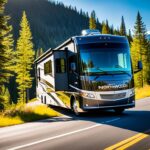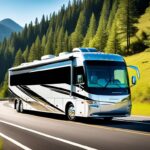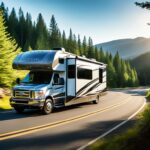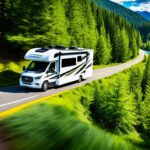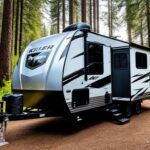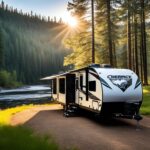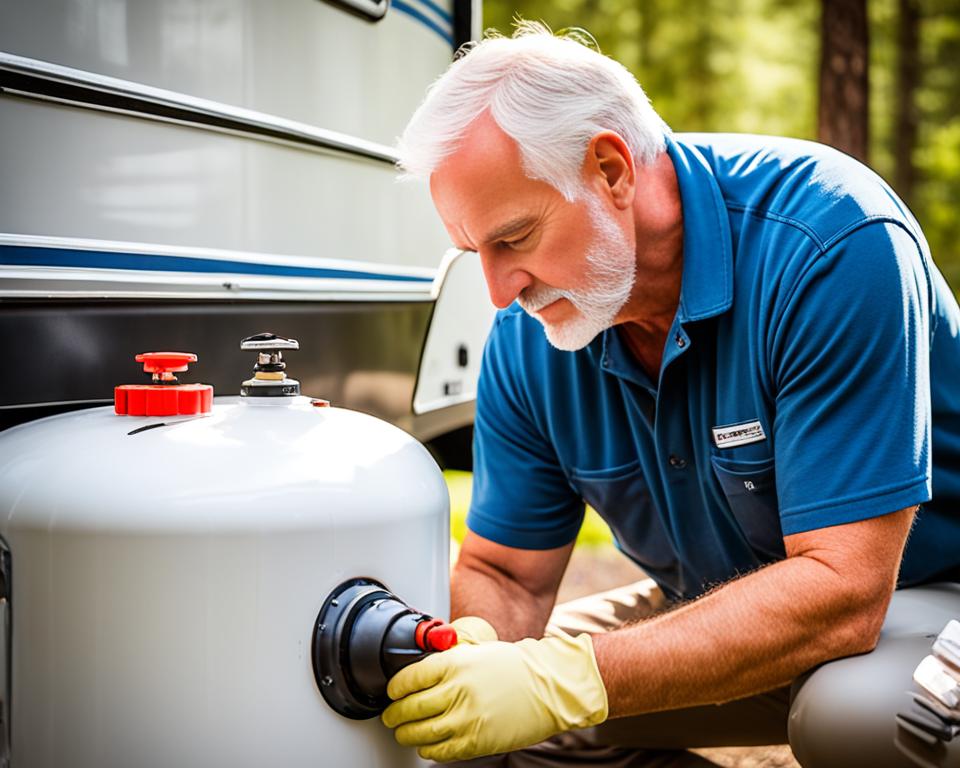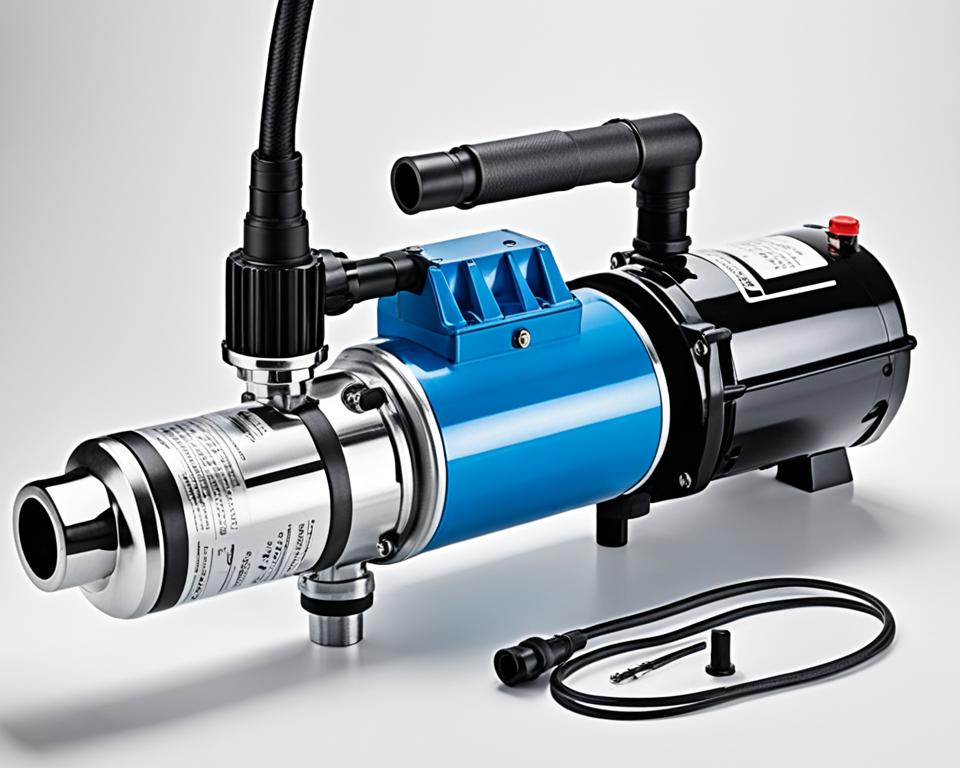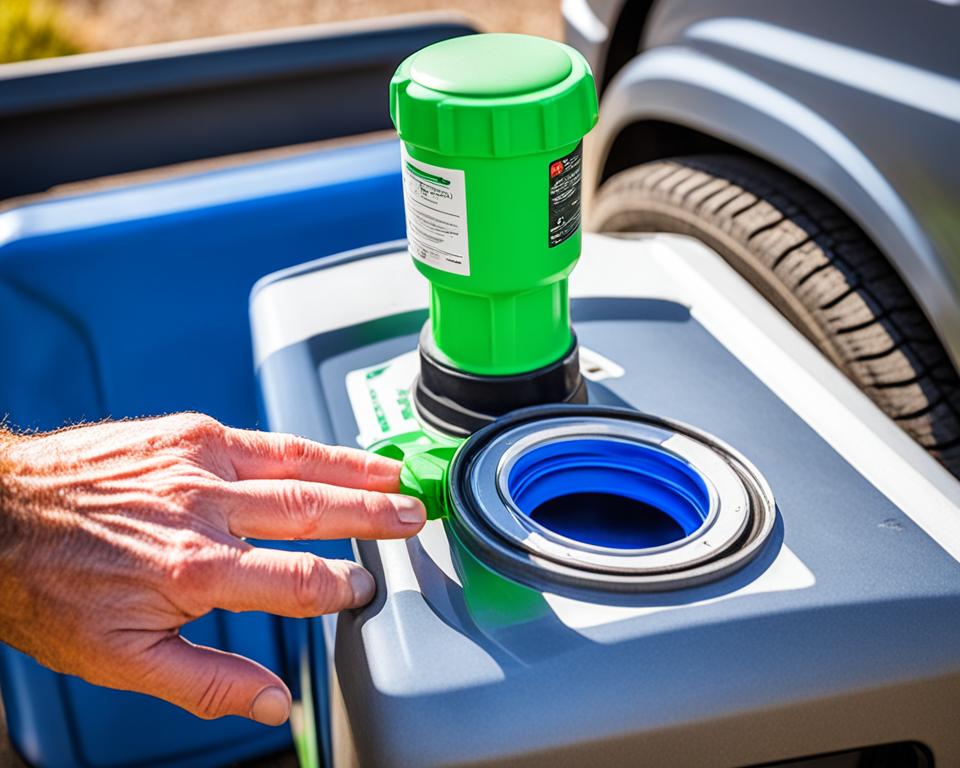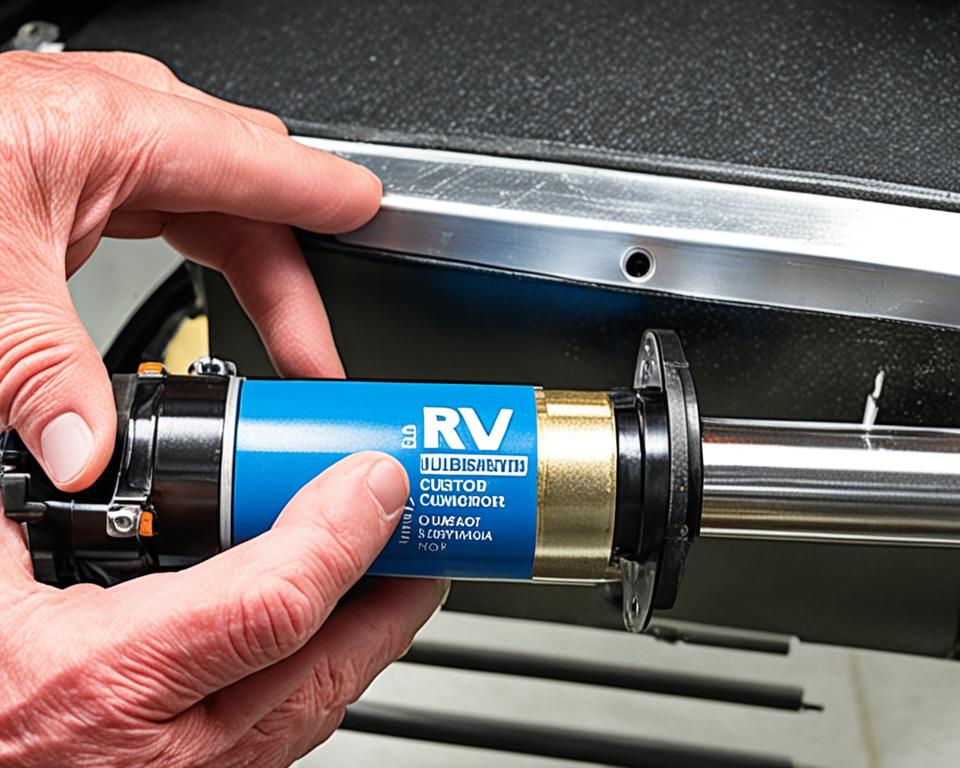Maintaining your RV water system is essential for a smooth and enjoyable trip on the road. By following these affordable RV water system maintenance tips, you can keep your water system running smoothly without breaking the bank. These cost-effective tips will help you ensure that your water is clean and safe for all your needs in the RV.
Key Takeaways:
- Inexpensive RV water system care is crucial for a smooth and enjoyable RV experience.
- RV water system maintenance on a budget is achievable with these affordable tips.
- Low-cost RV water system maintenance doesn’t mean sacrificing quality.
- Budget-friendly RV water system care can help you save money in the long run.
- Cost-effective RV water system maintenance ensures clean and safe water for your RV needs.
Sanitizing Your RV Water System
Properly sanitizing your RV water system is a crucial maintenance task to ensure clean and safe water for your travels. Spring is the ideal time to sanitize your water system, especially when taking your RV out of storage. By following a step-by-step process and using common household bleach, you can easily sanitize your RV water system and keep it running smoothly.
First, start by draining the water heater and opening all faucets to allow the water to drain completely. This step helps remove any stagnant water or residue in the system. Next, create a mixture of bleach and water in a ratio of 1/4 cup of bleach per 15 gallons of water in your fresh water tank.
Pro Tip: Ensure that you are using unscented bleach without any additives or fragrances.
After preparing the bleach and water mixture, add it to the fresh water tank. Make sure to fill the tank completely to ensure that the bleach reaches all parts of the water system. Once the mixture is added, run the water through all the faucets, including hot and cold water, until you smell the bleach. This ensures that the mixture has circulated through the entire system.
After running the bleach water through the faucets, let it sit in the system for at least 4 hours or overnight to allow the bleach to effectively sanitize the pipes, tanks, and fixtures. During this time, it’s best to keep your RV parked and avoid using the water system.
Once the sanitization time has passed, drain and flush the RV water system thoroughly. Open all the faucets and let the water run until you no longer smell bleach. It’s important to drain the entire system and refill it with fresh water to remove any remaining traces of bleach. This step ensures that your water is safe and free from any chemical residues.
Regularly sanitizing your RV water system helps prevent the growth of bacteria, algae, and other contaminants. It ensures that the water you use for drinking, cooking, and showering is clean and safe. By following this simple process using common bleach, you can easily maintain the sanitation of your RV water system.
Benefits of Sanitizing Your RV Water System:
- Ensures clean and safe water for drinking, cooking, and personal hygiene
- Prevents the growth of bacteria and algae in the water system
- Eliminates unpleasant smells and tastes caused by stagnant water
- Helps prolong the lifespan of your water system components
“Sanitizing your RV water system is a critical step in maintaining a healthy environment during your travels. With proper sanitization, you can enjoy clean and safe water wherever your adventures take you.”
Checking Fluid Levels and Batteries
Before hitting the road, it is essential to maintain proper fluid levels and battery charge in your RV. Regularly checking the fluid levels ensures the smooth functioning of various components, while maintaining the batteries guarantees reliable power supply throughout your journey. By following these simple steps, you can ensure a safe and worry-free RV experience.
Fluid Level Check
To keep your RV running smoothly, it is crucial to regularly check the fluid levels in your vehicle. Here’s a list of fluid levels you should inspect:
| Fluid | Check | Refill if Low |
|---|---|---|
| Power Steering | ✓ | ✓ |
| Transmission | ✓ | ✓ |
| Engine Oil | ✓ | ✓ |
| Brake Fluid | ✓ | ✓ |
| Engine Coolant | ✓ | ✓ |
| Windshield Washer Fluid | ✓ | ✓ |
Make sure to refill any low fluids to their recommended levels. This will help maintain the performance and longevity of your RV.
Battery Maintenance
The batteries in your RV play a crucial role in powering various systems, such as lights, appliances, and electronic devices. Follow these steps to ensure their optimal performance:
- Check the battery voltage using a voltmeter. It should read between 12.4 and 12.7 volts for a fully charged battery.
- If the battery was not recharged throughout the winter, use a battery charger to recharge it before your trip.
- For lead acid batteries, check the water levels and top up with distilled water if necessary. Ensure the plates are fully submerged, but not overfilled.
By maintaining proper fluid levels and battery charge in your RV, you can enjoy a reliable and hassle-free journey on the road.
Inspecting Tires and Looking for Leaks
Proper tire maintenance is crucial for RV safety. Regularly inspecting your tires and looking for leaks can help prevent accidents and costly repairs. Here are a few key steps to ensure the well-being of your RV’s tires:
- RV Tire Inspection: Begin by thoroughly inspecting all tires, including the spare, for any signs of damage or excessive wear. Check the tread depth and sidewalls for cracks, bulges, or uneven wear patterns. If you notice any abnormalities, it’s essential to address them promptly.
- Tire Pressure Check: Maintaining the correct tire pressure is crucial for safe RV operation. Use a reliable tire pressure gauge to check the pressure in each tire, including the spare. Refer to your RV’s manual or consult a tire professional to determine the recommended tire pressure. Inflation should be done when the tires are cold.
- Tire Wear and Tear: Uneven wear on your RV’s tires can indicate alignment or suspension issues. If you notice excessive or unusual tire wear patterns, consider having your RV’s alignment checked and suspension components inspected by a qualified technician.
- RV Sealant Inspection: Inspect your RV’s sealants, including those around windows, doors, and seams, for cracks or deteriorations. Proper sealing helps prevent water infiltration and potential damage. If you find any cracks or gaps, reseal them using RV-approved sealant to maintain a watertight interior.
Regularly inspecting your RV tires and addressing any issues promptly will go a long way in ensuring your safety on the road and preventing extensive repairs. Don’t forget that tire pressure should be checked regularly, especially before long trips.
Did You Know?
According to industry guidelines, RV tires should be replaced every five to seven years, regardless of the tire’s tread depth or visual condition. Aging tires pose a higher risk of failure, even if they appear to be in good condition.
In addition to tire inspections, it’s important to evaluate your RV’s overall condition regularly. By following proper maintenance practices, you can enjoy worry-free travels and make lasting memories.
| Tire Maintenance Tips | Benefits |
|---|---|
| Regularly check tire pressure | Proper tire inflation improves fuel efficiency and extends tire life |
| Inspect tires for signs of wear and tear | Identify potential issues early to prevent tire blowouts |
| Reseal RV seams and sealants if necessary | Protect against water damage and potential leaks |
De-Winterizing and Checking the Water System
If your RV was winterized, it needs to be de-winterized before use. This process involves removing the RV antifreeze and inspecting the water system to ensure it is in good working condition.
To de-winterize your RV water system, follow these steps:
- Flush out the RV Antifreeze: Start by connecting your RV to a fresh water source. Open all the faucets and let the water run until there is no trace of the pink RV antifreeze.
- Inspect the Water System: While flushing out the antifreeze, inspect the entire water system for any leaks or damage. Check for any cracks in the pipes, connections, or valves. Address any issues before using the water system.
- Replace Water Filter Cartridges: If you removed the water filter cartridges for winter storage, make sure to replace them with new ones. This ensures that the water passing through the system is clean and free from impurities.
By de-winterizing and checking your RV water system, you can ensure that it is ready for use and that you have clean and safe water during your travels.
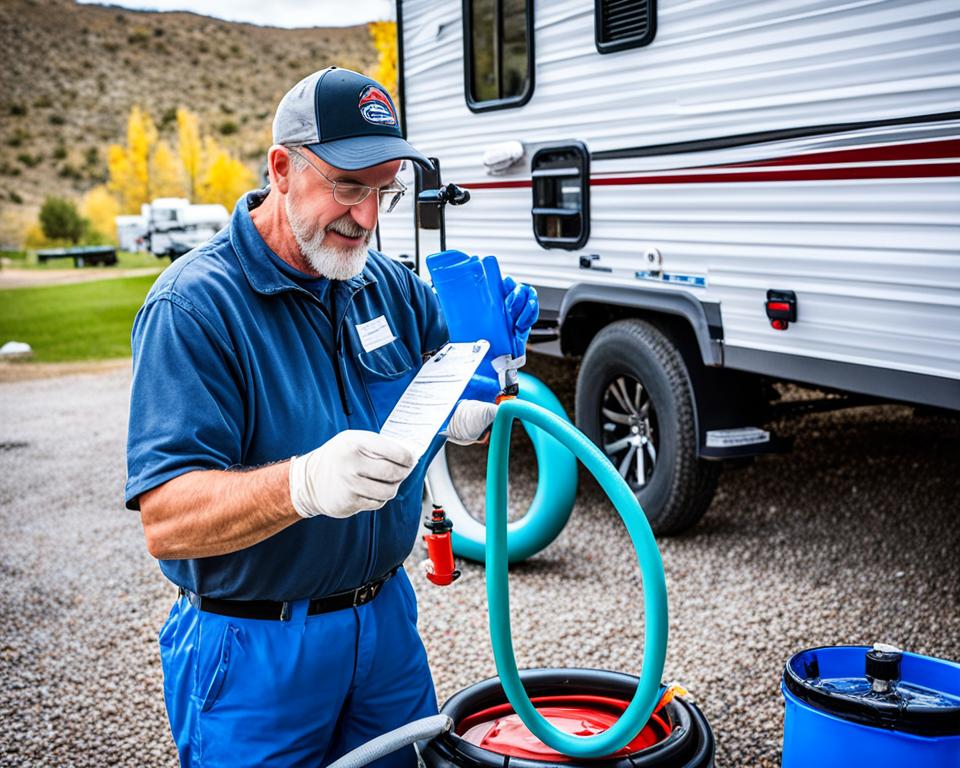
RV Water System De-Winterizing Checklist
| Steps | Description |
|---|---|
| Flush out the RV Antifreeze | Connect RV to a fresh water source and open all faucets to remove antifreeze |
| Inspect the Water System | Check for leaks, cracks, or damage in the water system components |
| Replace Water Filter Cartridges | Install new water filter cartridges for clean water filtration |
“De-winterizing your RV water system is an important step to ensure a successful camping season. By following these steps and thoroughly inspecting the system, you can avoid any potential issues and enjoy clean and fresh water throughout your trip.”
Checking Windows, Air Vents, and Safety Devices
To ensure a comfortable and safe environment inside your RV, it is important to regularly inspect and maintain the windows, air vents, and safety devices. These components play a crucial role in providing ventilation, preventing accidents, and ensuring your well-being during your RV adventures.
Start by checking the windows for proper functioning. Open them to allow fresh air to circulate and remove any excess humidity. This will not only keep the air inside your RV fresh and comfortable but also help prevent the buildup of moisture that can lead to mold and mildew growth.
Next, inspect the air vents to ensure they are clean and unobstructed. Blocked vents can restrict airflow and affect the overall ventilation in your RV. Clean any dust or debris that may have accumulated and verify that the vents can be opened and closed without any issues.
Once you have checked the windows and air vents, it is crucial to verify the functionality of your safety devices. Start by testing the smoke alarm. Press the test button and ensure that it emits a loud, audible signal. If the smoke alarm is not functioning properly, replace it immediately with a new one.
Similarly, inspect the fire extinguisher to ensure it is fully charged and easily accessible. Check the pressure gauge and verify that it is within the recommended range. If the fire extinguisher is expired or has been used, replace it promptly to ensure your safety in case of emergencies.
In addition to smoke alarms and fire extinguishers, remember to check the carbon monoxide detector and LP detector in your RV. These devices are essential for detecting potentially dangerous gases and alerting you to their presence. Follow the manufacturer’s instructions for testing and ensure that both detectors are functioning correctly. Replace them if they are expired or damaged.
By regularly inspecting and maintaining the windows, air vents, and safety devices in your RV, you can create a safe and comfortable environment for your travels. A few minutes of preventive maintenance can go a long way in ensuring your peace of mind throughout your RV adventures.
Checking the Towing Setup
If you’re towing a car behind your RV, it is crucial to inspect the towing setup before your trip. Ensuring the safety and stability of your towing rig is essential for a smooth and worry-free journey. By conducting a thorough inspection, you can identify any potential issues and address them before hitting the road.
Inspecting Towing Connections and Welds
Start by closely examining all the towing connections and welds. Look for any signs of damage, such as cracks or excessive wear. Pay special attention to areas where the trailer hitch and the RV frame are joined. Even small cracks can compromise the structural integrity of the towing setup.
Checking Safety Chains and Hitch Pieces
The safety chains play a crucial role in keeping the towed vehicle secure in case of an unexpected separation. Make sure that the safety chains are crossed under the coupling and properly hooked onto the appropriate attachment points. Inspect the chains for any signs of damage or excessive rust, and replace them if necessary.
Additionally, carefully examine the hitch pieces for any rust, wear, or damage. Pay attention to the hitch ball, receiver, and any other components involved in the towing setup. If you notice any broken or worn-out parts, it’s important to replace them to maintain the towing rig’s reliability.
Remember, a well-maintained towing setup is crucial for safe and hassle-free towing. By taking the time to inspect the towing connections and welds, as well as checking the safety chains and hitch pieces, you can ensure the security of your vehicle during your RV adventures.
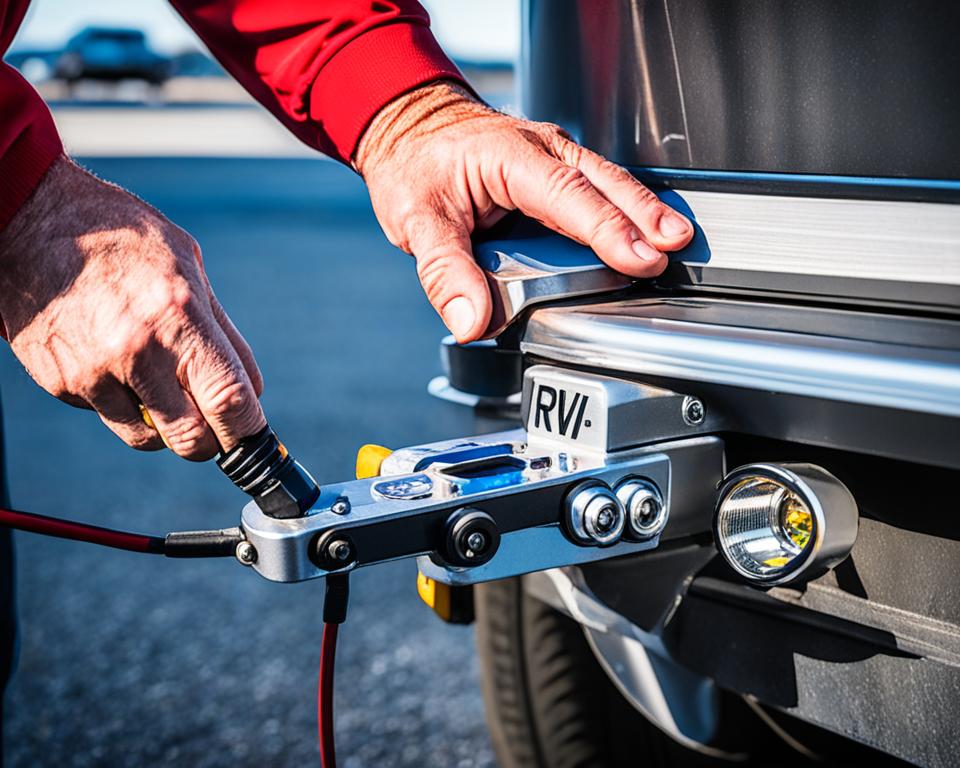
| Inspection Checklist | Actions |
|---|---|
| Inspect towing connections and welds | Look for cracks or damage and address any issues |
| Check safety chains | Cross under the coupling and ensure proper hooking |
| Examine hitch pieces | Look for rust, wear, or damage, and replace broken parts |
Proper RV Sanitation
Maintaining proper sanitation in your RV is vital for the health and comfort of everyone on board. By following recommended practices for RV sanitation, you can ensure a clean and sanitary environment throughout your journey. This section will cover essential aspects of RV sanitation, including waste tank maintenance, black water tank care, grey water tank care, RV toilet maintenance, and holding tank treatment. Implementing these practices will help you keep your RV clean, odor-free, and sanitary.
Waste Tank Maintenance
Proper waste tank maintenance is crucial for maintaining the cleanliness of your RV’s plumbing system. To ensure optimal performance and minimize odors, it is important to regularly empty and clean your waste tanks. Here are some key practices to follow:
- Regularly empty your waste tanks at designated RV dump stations. Avoid dumping waste in improper locations, such as storm drains or natural water sources, as it can have negative environmental impacts.
- Use RV-friendly toilet paper that dissolves easily in water to prevent clogging and promote efficient waste breakdown.
- Add holding tank treatment products to your waste tanks to control odors, break down waste, and promote the growth of beneficial bacteria.
- Consider using enzyme-based treatments that are eco-friendly and help break down waste more effectively.
Black Water Tank Care
The black water tank holds solid waste from the RV toilet. Proper care and maintenance of the black water tank will help prevent clogs, control odors, and ensure the longevity of your RV’s plumbing system. Here are some tips for black water tank care:
- Regularly flush your black water tank to remove solids and prevent buildup. Use a designated black water tank flush system if your RV is equipped with one.
- Avoid using harsh chemicals or cleaners that can damage the tank or harm the environment. Instead, use RV-specific black water tank treatment products that are safe and effective in breaking down waste.
- Maintain proper ventilation in your RV to prevent odors from escaping the black water tank. Ensure that all tank vents are clear and unobstructed.
Grey Water Tank Care
The grey water tank stores wastewater from sinks, showers, and appliances. Although it doesn’t contain solid waste like the black water tank, it still requires proper care to prevent odors and maintain optimal functionality. Here are some tips for grey water tank care:
- Regularly drain your grey water tank at designated RV dump stations. Avoid letting the tank become full, as it can lead to unpleasant odors and potential plumbing issues.
- Use environmentally-friendly grey water tank treatment products to control odors and promote the breakdown of grease and soap residue.
- Consider using food strainers or filters in your RV’s sinks to prevent food particles and debris from entering the grey water tank.
RV Toilet Maintenance
The RV toilet is an essential component of the RV’s sanitation system. Proper maintenance and care of the toilet will help prevent clogs, control odors, and ensure a hygienic environment in your RV. Here are some tips for RV toilet maintenance:
- Regularly clean and sanitize your RV toilet to prevent the buildup of bacteria and odors. Use RV-specific toilet cleaners that are safe for plastic toilets and won’t damage the seals or components.
- Avoid using excessive amounts of toilet paper, as it can lead to clogs. Use the recommended amount and ensure it is RV-friendly toilet paper that dissolves easily.
- Inspect the toilet seals regularly and replace them if they show signs of wear or leaks. Properly functioning seals are essential for preventing any odor or liquid leakage from the toilet.
Holding Tank Treatment
Using the right holding tank treatment is crucial for maintaining a clean and odor-free RV. Holding tank treatments contain chemicals or enzymes that help promote waste breakdown, control odors, and improve overall tank performance. Here are some key points to consider:
- Choose holding tank treatments that are compatible with your RV’s plumbing system and tanks. Read product labels and follow the manufacturer’s instructions for proper application and usage.
- Consider using eco-friendly holding tank treatments that are non-toxic and biodegradable.
- Use holding tank treatments regularly, especially after emptying your waste tanks, to maintain optimal performance and control odors.
By following these guidelines for proper RV sanitation, waste tank maintenance, black water tank care, grey water tank care, RV toilet maintenance, and holding tank treatment, you can ensure a clean and sanitary environment in your RV. Taking care of these essential aspects will contribute to a more enjoyable and comfortable RVing experience.
Budget-Friendly Tips for RV Water System Care
Taking care of your RV water system doesn’t have to break the bank. There are several budget-friendly tips to help you maintain your water system without spending a fortune.
- DIY solutions for sanitizing your water system: Instead of hiring professionals, you can sanitize your RV water system using simple household products. For example, you can create a bleach and water mixture to clean and disinfect your fresh water tank, faucets, and pipes.
- Using affordable RV-friendly products for maintenance: Look for cost-effective products specifically designed for RV water system care. These products are often priced competitively and can help you maintain the quality of your water system without breaking the bank.
- Adopting water conservation practices: Conserving water not only helps the environment but also reduces the wear and tear on your RV water system. Implementing practices such as using water-saving showerheads, fixing leaks promptly, and reusing water when possible can significantly extend the lifespan of your system.
By implementing these tips, you can effectively care for your RV water system while staying within your budget.
Remember, maintaining your RV water system doesn’t have to be expensive. With a little DIY effort and smart choices, you can keep your water system in great condition without breaking the bank.
Conclusion
Keeping your RV water system well-maintained is crucial for a smooth and enjoyable RV experience. By following these affordable RV water system maintenance tips and performing regular checks on your RV’s fluids, batteries, tires, and safety devices, you can ensure the longevity and reliability of your water system.
Take the time to de-winterize and inspect your water system, as well as properly sanitize and care for it. Regular sanitization using Clorox bleach and flushing the system ensures that your water is clean and safe for use.
With these budget-friendly tips, you can maintain your RV water system without breaking the bank. Don’t forget to check and refill the fluid levels, monitor tire pressure, and inspect the towing setup. Additionally, proper care of your windows, air vents, safety devices, and sanitation systems is essential for a comfortable and safe RV trip. By implementing these maintenance practices, you can enjoy worry-free travels and ensure a reliable water system in your RV.
FAQ
How often should I sanitize my RV water system?
It is recommended to sanitize your water system every spring when you take your RV out of storage.
How do I sanitize my RV water system?
You can sanitize your RV water system by draining the water heater, opening all faucets to drain the water, adding a bleach and water mixture to the fresh water tank, running the water through all faucets, and then draining and refilling the system.
What fluids should I check in my RV?
You should check the fluid levels of your power steering, transmission, engine oil, brake fluid, engine coolant, and windshield washer fluid.
How often should I check my RV battery?
If your RV battery was not recharged throughout the winter, it is important to check it before hitting the road. Recharge the battery if needed and check the water levels for lead acid batteries.
How do I maintain my RV tires?
To maintain your RV tires, check the tire pressure in all your RV tires, including the spare. Look for signs of wear and tear and cracks in the tires’ sidewalls. Inflate the tires to the recommended levels if the pressure is low.
How do I de-winterize my RV water system?
To de-winterize your RV water system, run fresh water through the system to remove any remaining RV antifreeze. Inspect the water system for leaks and replace any water filter cartridges that were removed for storage.
How do I check the windows and air vents in my RV?
Check the windows and air vents in your RV for proper functioning. Open them for airflow and remove any excess humidity.
How often should I check the safety devices in my RV?
It is important to regularly check the smoke alarm, fire extinguisher, carbon monoxide detector, and LP detector in your RV. Replace any expired fire extinguishers and ensure that all safety devices are in good working condition.
How do I inspect the towing setup for my RV?
Inspect the towing connections and welds for any damage or cracks. Check that the safety chains are crossed under the coupling and correctly hooked. Inspect the hitch pieces for rust or damage and replace any broken parts.
How do I maintain proper sanitation in my RV?
Maintain proper sanitation in your RV by following recommended practices for waste tank maintenance, treating the black water and grey water tanks with appropriate chemicals, and regularly cleaning and sanitizing your RV toilet.
What are some budget-friendly tips for RV water system care?
Some budget-friendly tips include DIY solutions for sanitizing your water system, using affordable RV-friendly products for maintenance, and adopting water conservation practices to reduce wear and tear on your water system.



